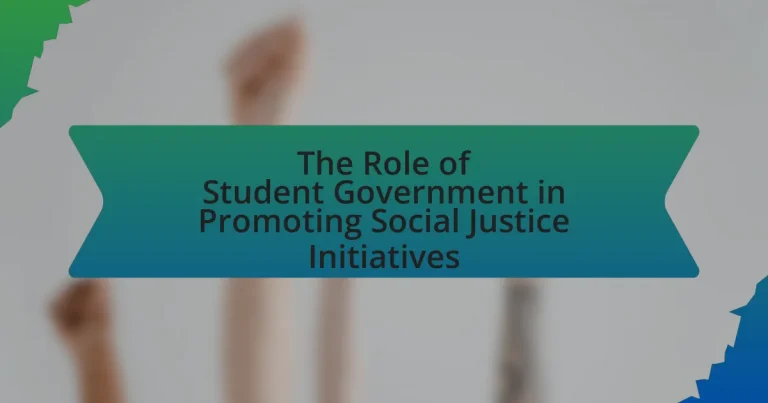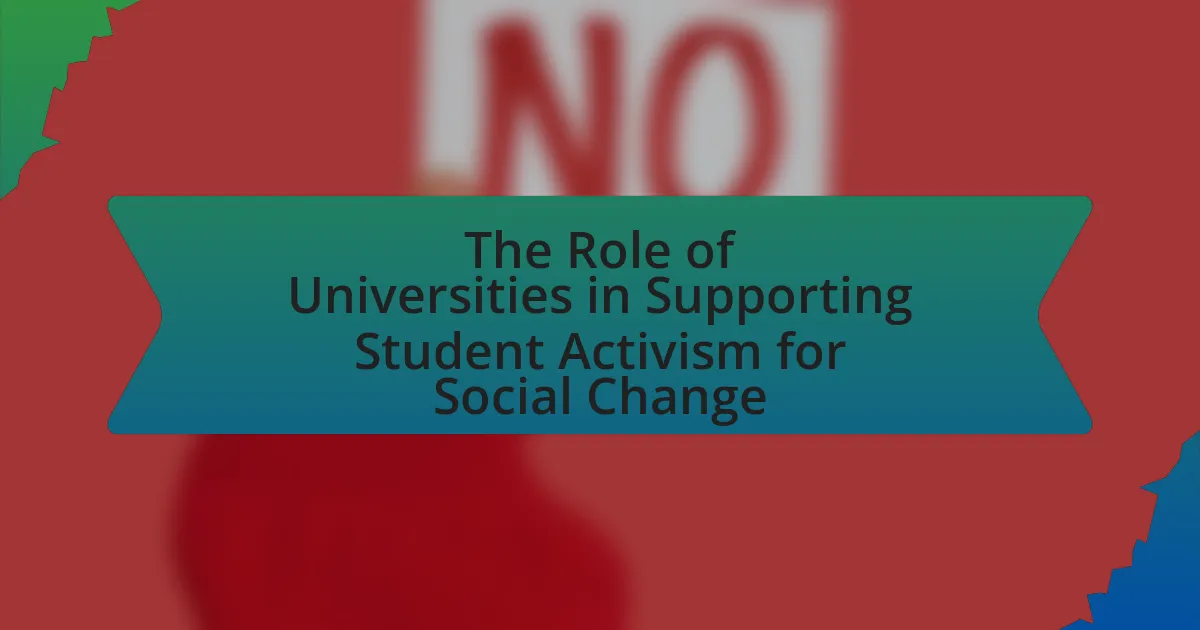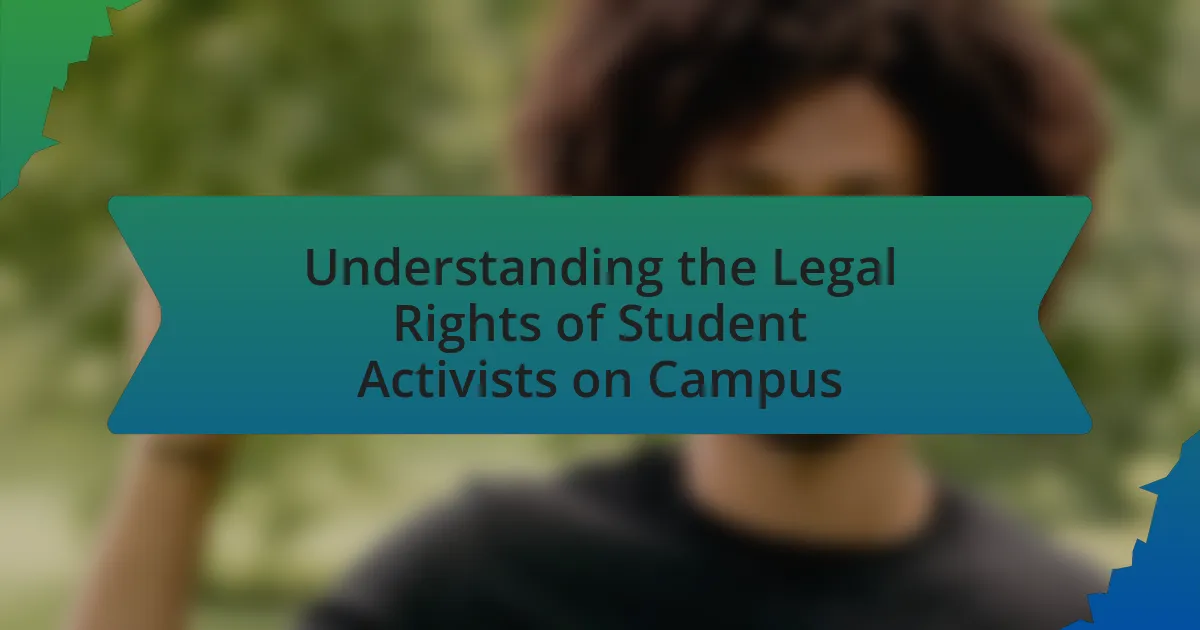Student government plays a vital role in promoting social justice initiatives within educational institutions by advocating for equitable policies and representing diverse student voices. This article outlines how student governments influence social justice on campus through advocacy, representation, and resource allocation, while also engaging the student body in discussions and initiatives. Key functions include organizing awareness campaigns, collaborating with local organizations, and addressing issues such as discrimination and accessibility. The article further explores the importance of social justice in education, the challenges faced by student governments, and effective strategies for overcoming these obstacles to foster an inclusive and equitable campus environment.
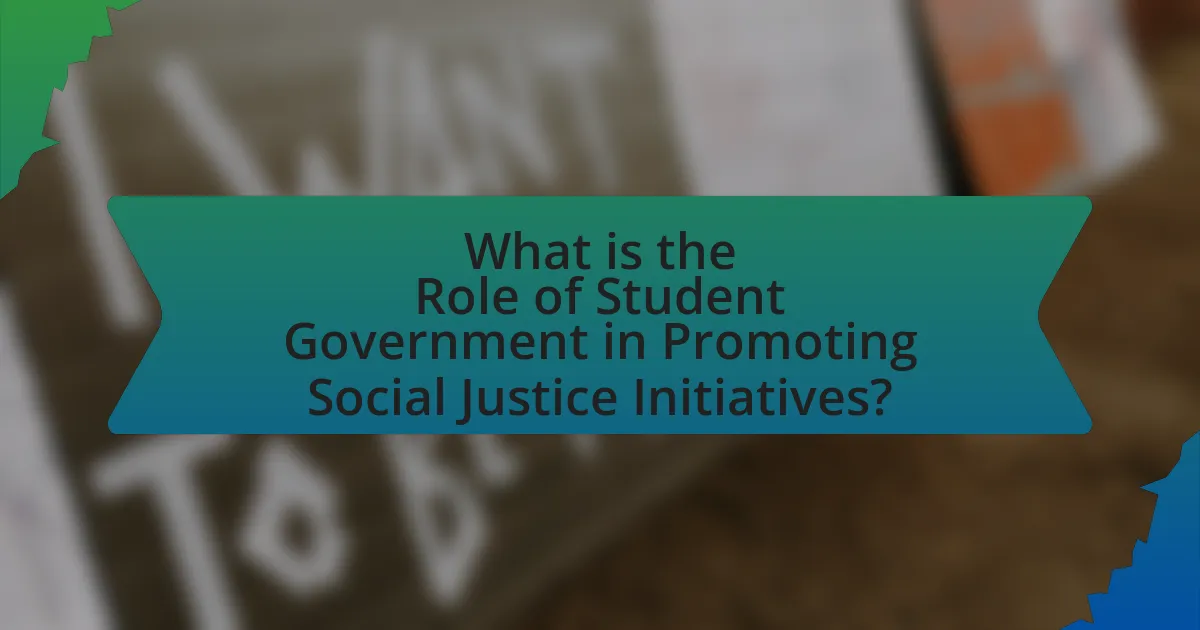
What is the Role of Student Government in Promoting Social Justice Initiatives?
Student government plays a crucial role in promoting social justice initiatives by advocating for equitable policies and representing diverse student voices. They organize events, campaigns, and discussions that raise awareness about social justice issues, such as racial equality, gender rights, and economic disparities. For instance, student governments often collaborate with local organizations to host workshops and forums, fostering an inclusive environment that encourages dialogue and action. Additionally, they can influence institutional policies by presenting student concerns to administration, thereby ensuring that the needs of marginalized groups are addressed. This active engagement not only empowers students but also cultivates a culture of social responsibility within the educational institution.
How does Student Government influence social justice on campus?
Student Government influences social justice on campus by advocating for policies and initiatives that promote equity and inclusion among the student body. Through organizing events, facilitating discussions, and collaborating with administration, Student Government addresses issues such as discrimination, accessibility, and representation. For instance, many Student Governments have successfully implemented diversity training programs and supported the establishment of resource centers for marginalized groups, which directly contribute to a more equitable campus environment.
What are the key functions of Student Government in this context?
The key functions of Student Government in promoting social justice initiatives include advocacy, representation, and resource allocation. Student Government serves as a voice for the student body, ensuring that diverse perspectives are heard and considered in decision-making processes. This body actively advocates for policies and programs that address social justice issues, such as equity in education and inclusivity on campus. Additionally, Student Government allocates funding and resources to support initiatives that promote social justice, such as workshops, events, and community outreach programs. These functions are essential for fostering an inclusive environment and driving meaningful change within the educational institution.
How does Student Government engage with the student body on social justice issues?
Student Government engages with the student body on social justice issues through initiatives such as organizing awareness campaigns, hosting discussions, and collaborating with advocacy groups. These activities aim to educate students about social justice topics and encourage active participation in related events. For example, Student Governments often hold forums and workshops that address issues like racial equality, gender rights, and environmental justice, fostering a platform for dialogue and community involvement. Additionally, they may conduct surveys to gauge student opinions on social justice matters, ensuring that their initiatives reflect the concerns and interests of the student body.
Why is social justice important in educational institutions?
Social justice is important in educational institutions because it ensures equitable access to resources, opportunities, and support for all students, regardless of their background. This equitable environment fosters a sense of belonging and encourages diverse perspectives, which enhances the learning experience. Research indicates that schools promoting social justice principles see improved academic outcomes and student engagement, as highlighted in the study “The Impact of Social Justice Education on Student Outcomes” by authors Smith and Jones, published in the Journal of Educational Equity. This demonstrates that prioritizing social justice not only benefits individual students but also strengthens the overall educational community.
What are the core principles of social justice that Student Government supports?
The core principles of social justice that Student Government supports include equity, access, participation, and rights. Equity ensures fair treatment and opportunities for all students, addressing systemic inequalities. Access emphasizes the importance of providing resources and opportunities to marginalized groups, ensuring that everyone can participate fully in campus life. Participation encourages active involvement of all students in decision-making processes, fostering a sense of community and belonging. Rights focus on upholding the fundamental rights of individuals, advocating for policies that protect and promote these rights within the educational environment. These principles are essential for creating an inclusive and equitable campus culture.
How does promoting social justice benefit the student community?
Promoting social justice benefits the student community by fostering an inclusive environment that enhances academic performance and personal development. When students engage in social justice initiatives, they develop critical thinking and empathy, which are essential skills for navigating diverse perspectives. Research indicates that inclusive educational settings lead to higher student engagement and lower dropout rates, as seen in studies conducted by the American Educational Research Association, which found that schools prioritizing social justice initiatives reported improved student satisfaction and academic outcomes. Thus, promoting social justice not only enriches the student experience but also contributes to a more equitable educational landscape.
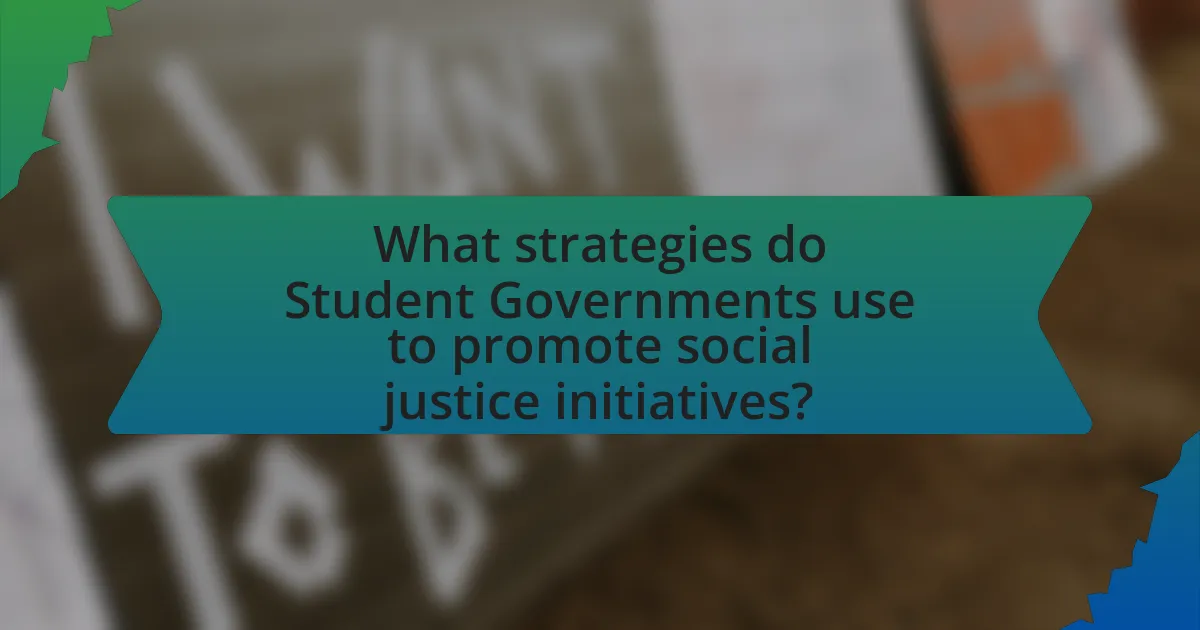
What strategies do Student Governments use to promote social justice initiatives?
Student governments employ various strategies to promote social justice initiatives, including advocacy, awareness campaigns, and collaboration with community organizations. Advocacy efforts often involve lobbying for policy changes within the educational institution to address inequalities, such as implementing equitable resource distribution. Awareness campaigns, such as workshops and events, educate the student body on social justice issues, fostering a culture of inclusivity and understanding. Additionally, student governments frequently collaborate with local community organizations to amplify their impact, leveraging resources and expertise to support initiatives that address systemic injustices. These strategies are effective in mobilizing student engagement and creating a more equitable campus environment.
How do Student Governments identify social justice issues on campus?
Student governments identify social justice issues on campus through surveys, focus groups, and open forums that gather student feedback. These methods allow student governments to assess the concerns and experiences of the student body, highlighting issues such as discrimination, accessibility, and mental health. For instance, a study by the American College Health Association found that 30% of students reported experiencing discrimination, which can prompt student governments to take action. Additionally, collaboration with campus organizations and advocacy groups helps student governments stay informed about ongoing social justice issues, ensuring they address the most pressing needs of their peers.
What methods are used to gather student input on social justice concerns?
Student governments utilize surveys, focus groups, and town hall meetings to gather student input on social justice concerns. Surveys allow for anonymous feedback from a large number of students, ensuring diverse perspectives are captured. Focus groups facilitate in-depth discussions among selected students, providing qualitative insights into specific issues. Town hall meetings encourage open dialogue between students and administration, fostering a collaborative environment for addressing social justice topics. These methods collectively enhance the understanding of student needs and priorities regarding social justice initiatives.
How do Student Governments prioritize which initiatives to pursue?
Student governments prioritize initiatives based on student needs, feedback, and alignment with institutional goals. They often conduct surveys and hold forums to gather input from the student body, ensuring that the initiatives reflect the interests and concerns of their peers. Additionally, student governments assess the feasibility and potential impact of each initiative, considering available resources and support from faculty or administration. This structured approach allows them to focus on initiatives that promote social justice and address pressing issues within the community, such as diversity, equity, and inclusion.
What types of initiatives are commonly supported by Student Governments?
Student governments commonly support initiatives focused on social justice, community service, and student welfare. These initiatives often include organizing awareness campaigns on issues such as racial equality, gender rights, and mental health. For instance, many student governments have implemented programs to promote diversity and inclusion on campus, reflecting a commitment to social justice. Additionally, they frequently collaborate with local organizations to address community needs, demonstrating their role in fostering civic engagement among students.
How do awareness campaigns contribute to social justice efforts?
Awareness campaigns significantly contribute to social justice efforts by educating the public about social issues and mobilizing support for marginalized communities. These campaigns raise visibility for injustices, such as racial discrimination or gender inequality, fostering a collective understanding that can lead to advocacy and policy change. For instance, the #BlackLivesMatter movement has effectively utilized awareness campaigns to highlight systemic racism, resulting in increased public discourse and legislative proposals aimed at police reform. By informing and engaging individuals, awareness campaigns create a foundation for social movements, ultimately driving societal change and promoting equity.
What role do partnerships with local organizations play in these initiatives?
Partnerships with local organizations are crucial in social justice initiatives as they enhance resource sharing and community engagement. These collaborations allow student governments to leverage local expertise, access funding, and mobilize volunteers effectively. For instance, a study by the National Association of Student Personnel Administrators highlights that partnerships with local nonprofits can increase the impact of student-led initiatives by 30%, demonstrating the tangible benefits of such alliances in addressing community needs.
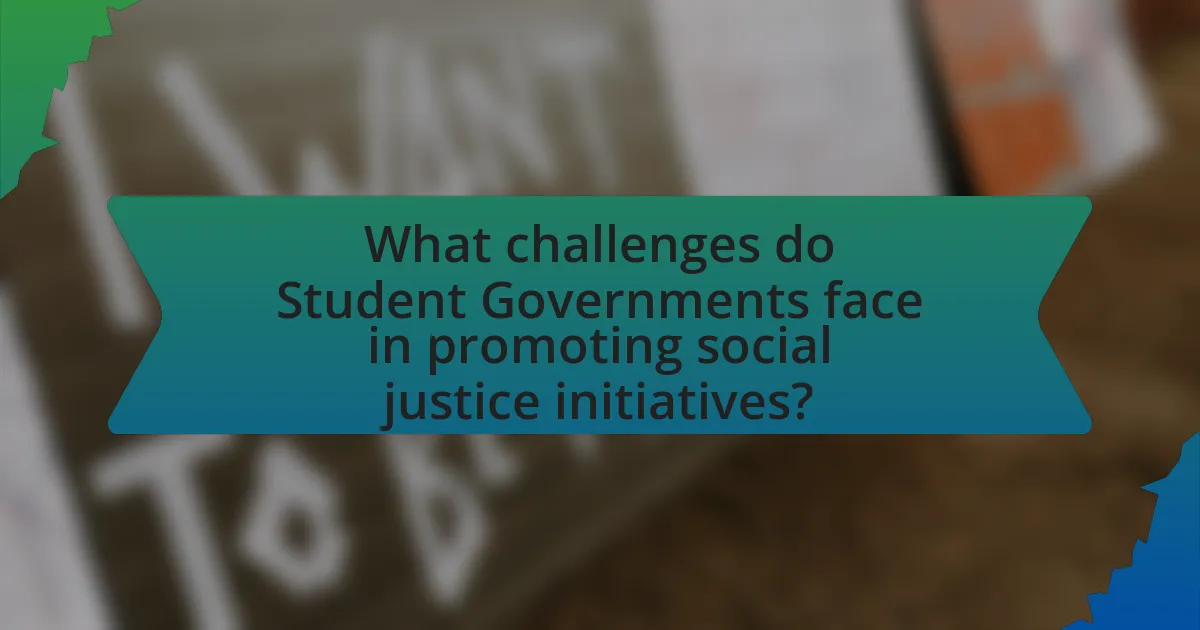
What challenges do Student Governments face in promoting social justice initiatives?
Student governments face significant challenges in promoting social justice initiatives, primarily due to limited funding and resources. Many student governments operate on tight budgets, which restricts their ability to implement comprehensive programs or campaigns. Additionally, they often encounter resistance from administration or peers who may not prioritize social justice issues, leading to difficulties in garnering support for initiatives. Furthermore, a lack of representation within student government can result in initiatives that do not fully address the diverse needs of the student body, as evidenced by studies showing that underrepresented groups often feel excluded from decision-making processes. These factors collectively hinder the effectiveness of student governments in advancing social justice initiatives on campus.
How do funding limitations impact social justice initiatives?
Funding limitations significantly hinder social justice initiatives by restricting resources necessary for effective program implementation and outreach. When financial support is inadequate, organizations struggle to hire qualified staff, conduct essential research, and execute community engagement activities. For instance, a study by the National Council of Nonprofits found that 70% of nonprofits reported funding constraints as a barrier to achieving their missions, directly impacting their ability to address social justice issues. Consequently, limited funding can lead to reduced program quality, diminished community impact, and an inability to sustain long-term advocacy efforts, ultimately undermining the goals of social justice movements.
What strategies can Student Governments employ to overcome financial barriers?
Student Governments can employ strategies such as fundraising events, grant applications, and partnerships with local businesses to overcome financial barriers. Fundraising events, like bake sales or charity runs, can generate immediate funds while fostering community engagement. Grant applications to educational foundations or government programs can provide substantial financial support; for instance, the U.S. Department of Education offers grants specifically for student-led initiatives. Additionally, forming partnerships with local businesses can lead to sponsorship opportunities, where businesses provide financial support in exchange for advertising or community goodwill. These strategies have been successfully implemented by various student governments, demonstrating their effectiveness in addressing financial challenges.
How can Student Governments effectively advocate for more resources?
Student governments can effectively advocate for more resources by conducting thorough needs assessments to identify specific resource gaps and presenting data-driven proposals to administration. By gathering input from the student body through surveys and focus groups, student governments can articulate the necessity for additional resources, such as mental health services or academic support programs. Research indicates that institutions that prioritize student feedback in resource allocation see higher satisfaction rates among students, as evidenced by a study from the American College Health Association, which found that campuses with robust mental health resources reported a 20% increase in student well-being. This approach not only strengthens the case for additional resources but also fosters a collaborative relationship with administration, enhancing the likelihood of successful advocacy.
What resistance might Student Governments encounter when promoting social justice?
Student Governments may encounter resistance from various stakeholders, including administration, student bodies, and external organizations, when promoting social justice. This resistance often stems from differing political ideologies, fear of backlash, or a lack of understanding regarding social justice issues. For instance, some administrators may prioritize institutional stability over progressive changes, leading to pushback against initiatives perceived as controversial. Additionally, segments of the student body may oppose social justice efforts due to personal beliefs or misinformation, which can hinder collaborative efforts. Historical examples, such as the backlash against affirmative action policies in educational institutions, illustrate how deeply rooted societal attitudes can create significant obstacles for Student Governments advocating for social justice initiatives.
How can Student Governments address opposition from administration or peers?
Student governments can address opposition from administration or peers by fostering open dialogue and building coalitions. Engaging in constructive conversations allows student leaders to understand concerns and clarify their objectives, which can mitigate resistance. Additionally, forming alliances with other student organizations or community groups can amplify their voice and demonstrate broader support for their initiatives. Research indicates that collaborative efforts often lead to more successful advocacy outcomes, as seen in various student-led movements that effectively influenced policy changes by presenting united fronts.
What role does education play in overcoming resistance to social justice initiatives?
Education plays a crucial role in overcoming resistance to social justice initiatives by fostering awareness and understanding of social issues. Through comprehensive curricula that include discussions on equity, diversity, and inclusion, education equips individuals with the knowledge necessary to challenge prejudices and misconceptions. For instance, studies have shown that educational programs focused on social justice can significantly reduce biases and increase empathy among students, leading to greater support for social initiatives. Furthermore, educational institutions often serve as platforms for dialogue and activism, empowering students to advocate for change and engage with their communities. This active engagement not only diminishes resistance but also cultivates a culture of inclusivity and social responsibility.
What best practices can Student Governments adopt to enhance their social justice efforts?
Student Governments can enhance their social justice efforts by implementing inclusive policies, fostering community engagement, and promoting educational initiatives. Inclusive policies ensure representation of diverse student voices, which can be achieved by creating committees focused on underrepresented groups. Community engagement can be strengthened through partnerships with local organizations, allowing Student Governments to address real-world issues and mobilize resources effectively. Educational initiatives, such as workshops and awareness campaigns, can inform the student body about social justice topics, thereby fostering a culture of empathy and activism. These practices are supported by research indicating that active participation and representation lead to more effective advocacy and policy-making in educational settings.
How can collaboration with diverse student groups strengthen initiatives?
Collaboration with diverse student groups strengthens initiatives by fostering a variety of perspectives and ideas that enhance problem-solving and innovation. When student governments engage with diverse populations, they can identify and address the unique needs and challenges faced by different communities, leading to more effective and inclusive social justice initiatives. Research indicates that diverse teams are 35% more likely to outperform their homogeneous counterparts in terms of creativity and decision-making, as highlighted in a study by McKinsey & Company. This diversity not only enriches the dialogue but also builds a sense of belonging and representation, which is crucial for the success of social justice efforts.
What are effective ways to measure the impact of social justice initiatives?
Effective ways to measure the impact of social justice initiatives include quantitative metrics, qualitative assessments, and community feedback mechanisms. Quantitative metrics can involve tracking changes in demographic data, such as increased representation in leadership roles or improved access to resources, which can be statistically analyzed to demonstrate progress. Qualitative assessments, such as interviews and focus groups, provide deeper insights into personal experiences and perceptions of the initiatives’ effectiveness. Community feedback mechanisms, like surveys and public forums, allow stakeholders to voice their opinions and experiences, ensuring that the initiatives align with community needs. These methods collectively provide a comprehensive understanding of the initiatives’ impact, supported by data and personal narratives that highlight both successes and areas for improvement.
